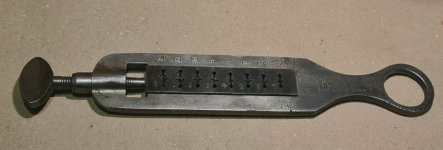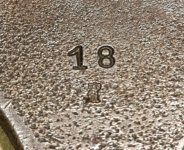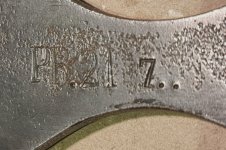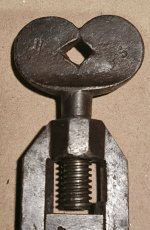KAGGR 1870
Member
How to identify screws and nuts used on infantry Maanschaften Pickelhaube.
Notice: This study only deal with screws and nuts used on foot troop helmets.
This study have two parts
I-Screws and nuts for mounts and wappens .
II- Screws and nuts for chinscales.
The reproduction of the wappens and the mounts by use of original die or “galvano” technique are more and more close to the originals.
So it becomes very difficult to distinguish the authentics and the fakes ( or copy).
The only place where we can, again, make difference is the nature of the screws
This, at the present time , show big differences with old screws.
So, the main problem is to know these differences to avoid fakes and restored helmets.
(Many helmets have a mixing of original and reproduction mounts parts)
I- Screws and nuts for mounts and wappens .
A- 1842-1915 period
Before the model 1895 we find screws, always brass made, on all mounts and wappens of the helmets except the Prussian model 1867 (this have no screws).
Bade and Saxon M67 helmet have, them, screwed wappens.
For M.95, except the small screw, brass made, located on rear spine at the level of the neck cover, we find only this screws on the extrahelm and Eigentumsstück (private purchase helmets).
Exception: Hessian helmets which have his mounts with screws (except the wappen with loops).
Whatever the model, all these screws have a special threading, very different from modern ISO metric thread and , as yet, it was not reproduced except by molding; but, in this case, we can see difference: the thread have no raised pattern and diameter is weaker.
Original screws have 3,4mm diameter with 10. metric old thread .
(3,4 mm is a middle of 18 measures)
The end of the screw have, more often, cutting marks ( this show that this screws was made from long brass threaded rod and cut with cutting pliers)
Here are, to illustrate, some examples of original screws with ,every time, for comparison, one screw with modern ISO thread and equivalent diameter.
1 - Screw of wappen M42, M60 and M71
2 - Screw of the rear spine M42, M60, M71
3 - Screws for M95 " eigetumstück " or Extra Helm
4 - Screws for hessian M95 helmet
5 - Screw of the rear spine M95
6 - Screw of the rear spine M15





B- M15 model:
This have only one iron screw at the level of the rear spine (neck cover).
Often with flat end. (mechanicals screws) or with cutting marks like brass screws.
We can find varied thread but very different of the old 10. thread.
I have observed:
- Diameter 3,2mm thread 0.6- (close to modern ISO metric thread 3/0.6)
- Diameter 3,5mm thread 0.9
C- Modern threads
The closest ISO metric threads, used on modern screws are:
Diameter 3mm thread 0.5 or 0.6
Diameter 4mm thread 0.7 or 0,75
D- Screw nuts
We can observe various types of nuts
-1- Brass nuts with loop, with diamond-shapped base, cast made and always present casting burrs.
It is the standard model observed on the old models (M42, M57, M60)
-2- Brass square nuts, with variable sizes, located on rear spine base ( at the neck cover level).
The oldest are thicker than M95 (This one have standardized shape)
-3- Iron square nuts found on Bade and Saxon M.67 wappens, Prussian M.71 helmets and later models, M15 rear spine and ersatz helmets


II-Screws and nuts of the chinscales .
Its appear on M.1842 chinscales with convex scales .
They are big screws, brass made, with very long head (I have no pic to show you)
This chinscale is modified in 1856 ( flat scales instead of convex scales)
with brass nuts and iron screw with round head;
this model will not change, any more, until 1887.
At this date, it disappear, except for guard and grenadier regiments, where it persists with a new system M.1891without screws. (This chinscales was worn only in parade).
On M.56 chinscales, we can found several types of nuts and screws
-A-The nuts
-1- Nuts in cast brass with full base (1th. type)
To my opinion, its are the oldest, salvaged from the M.42 type.
They are slightly conical with 7,5mm diameter on the base and 6mm to the top
Length 15mm; mounted with iron screw with small head.
-2- Nuts in cast brass with hollow base (2th. type) with a same diameter, mounted with iron screw with big head .
The hollow base help along the execution of the internal threading for the screw.


-3- Iron nuts, with full base ( M60): they are made, like nails, by press die-forging but never lathe made (we can see on the inner base metal burrs);
They are, thus, cylinder-shaped with 7 mm diameter.
There are two lengthes of nuts:
One short , on the left side, with 12,5 mm length and one longer with 15,7 mm length on the right side; this to counterbalance the thickness of the cocarde.
These nuts are observed on helmets M60, M67 and later pattern.
Interresting point: only once, I found on one of my helmets, never unsettled, this:
to prevent the wear of the leather, the base of the nut was covered by a small slice of dark blue cloth (see pic below)

-B-The screws
They are always iron made with round head;
Size: 4,5mm diameter, 10. thread. Total length 15mm.
We observe two types of round heads:
1 - Small head with 10,4mm diameter, the oldest (M56).
2 - Big head with 11,5 to 11, 8 mm diameter; the most common

Modern screws:
The closest have 5mm diameter with thread 0.9.
Regards (and sorry for my english mistakes)
B.V.2008
Notice: This study only deal with screws and nuts used on foot troop helmets.
This study have two parts
I-Screws and nuts for mounts and wappens .
II- Screws and nuts for chinscales.
The reproduction of the wappens and the mounts by use of original die or “galvano” technique are more and more close to the originals.
So it becomes very difficult to distinguish the authentics and the fakes ( or copy).
The only place where we can, again, make difference is the nature of the screws
This, at the present time , show big differences with old screws.
So, the main problem is to know these differences to avoid fakes and restored helmets.
(Many helmets have a mixing of original and reproduction mounts parts)
I- Screws and nuts for mounts and wappens .
A- 1842-1915 period
Before the model 1895 we find screws, always brass made, on all mounts and wappens of the helmets except the Prussian model 1867 (this have no screws).
Bade and Saxon M67 helmet have, them, screwed wappens.
For M.95, except the small screw, brass made, located on rear spine at the level of the neck cover, we find only this screws on the extrahelm and Eigentumsstück (private purchase helmets).
Exception: Hessian helmets which have his mounts with screws (except the wappen with loops).
Whatever the model, all these screws have a special threading, very different from modern ISO metric thread and , as yet, it was not reproduced except by molding; but, in this case, we can see difference: the thread have no raised pattern and diameter is weaker.
Original screws have 3,4mm diameter with 10. metric old thread .
(3,4 mm is a middle of 18 measures)
The end of the screw have, more often, cutting marks ( this show that this screws was made from long brass threaded rod and cut with cutting pliers)
Here are, to illustrate, some examples of original screws with ,every time, for comparison, one screw with modern ISO thread and equivalent diameter.
1 - Screw of wappen M42, M60 and M71
2 - Screw of the rear spine M42, M60, M71
3 - Screws for M95 " eigetumstück " or Extra Helm
4 - Screws for hessian M95 helmet
5 - Screw of the rear spine M95
6 - Screw of the rear spine M15





B- M15 model:
This have only one iron screw at the level of the rear spine (neck cover).
Often with flat end. (mechanicals screws) or with cutting marks like brass screws.
We can find varied thread but very different of the old 10. thread.
I have observed:
- Diameter 3,2mm thread 0.6- (close to modern ISO metric thread 3/0.6)
- Diameter 3,5mm thread 0.9
C- Modern threads
The closest ISO metric threads, used on modern screws are:
Diameter 3mm thread 0.5 or 0.6
Diameter 4mm thread 0.7 or 0,75
D- Screw nuts
We can observe various types of nuts
-1- Brass nuts with loop, with diamond-shapped base, cast made and always present casting burrs.
It is the standard model observed on the old models (M42, M57, M60)
-2- Brass square nuts, with variable sizes, located on rear spine base ( at the neck cover level).
The oldest are thicker than M95 (This one have standardized shape)
-3- Iron square nuts found on Bade and Saxon M.67 wappens, Prussian M.71 helmets and later models, M15 rear spine and ersatz helmets


II-Screws and nuts of the chinscales .
Its appear on M.1842 chinscales with convex scales .
They are big screws, brass made, with very long head (I have no pic to show you)
This chinscale is modified in 1856 ( flat scales instead of convex scales)
with brass nuts and iron screw with round head;
this model will not change, any more, until 1887.
At this date, it disappear, except for guard and grenadier regiments, where it persists with a new system M.1891without screws. (This chinscales was worn only in parade).
On M.56 chinscales, we can found several types of nuts and screws
-A-The nuts
-1- Nuts in cast brass with full base (1th. type)
To my opinion, its are the oldest, salvaged from the M.42 type.
They are slightly conical with 7,5mm diameter on the base and 6mm to the top
Length 15mm; mounted with iron screw with small head.
-2- Nuts in cast brass with hollow base (2th. type) with a same diameter, mounted with iron screw with big head .
The hollow base help along the execution of the internal threading for the screw.


-3- Iron nuts, with full base ( M60): they are made, like nails, by press die-forging but never lathe made (we can see on the inner base metal burrs);
They are, thus, cylinder-shaped with 7 mm diameter.
There are two lengthes of nuts:
One short , on the left side, with 12,5 mm length and one longer with 15,7 mm length on the right side; this to counterbalance the thickness of the cocarde.
These nuts are observed on helmets M60, M67 and later pattern.
Interresting point: only once, I found on one of my helmets, never unsettled, this:
to prevent the wear of the leather, the base of the nut was covered by a small slice of dark blue cloth (see pic below)

-B-The screws
They are always iron made with round head;
Size: 4,5mm diameter, 10. thread. Total length 15mm.
We observe two types of round heads:
1 - Small head with 10,4mm diameter, the oldest (M56).
2 - Big head with 11,5 to 11, 8 mm diameter; the most common

Modern screws:
The closest have 5mm diameter with thread 0.9.
Regards (and sorry for my english mistakes)
B.V.2008










